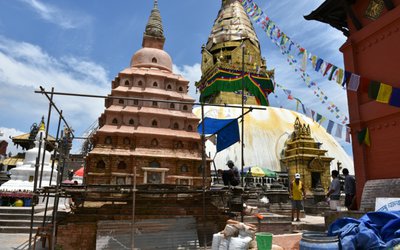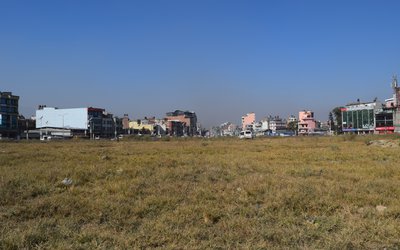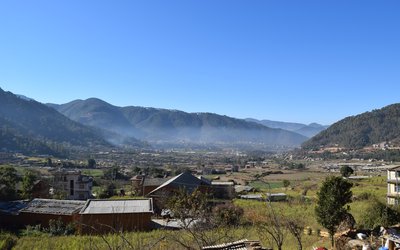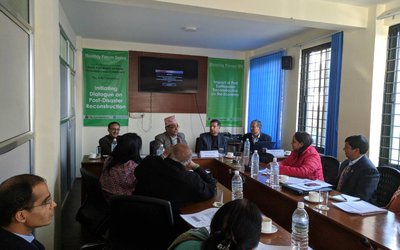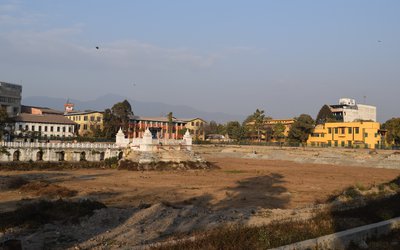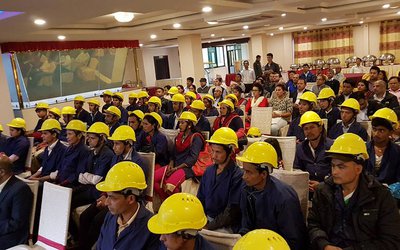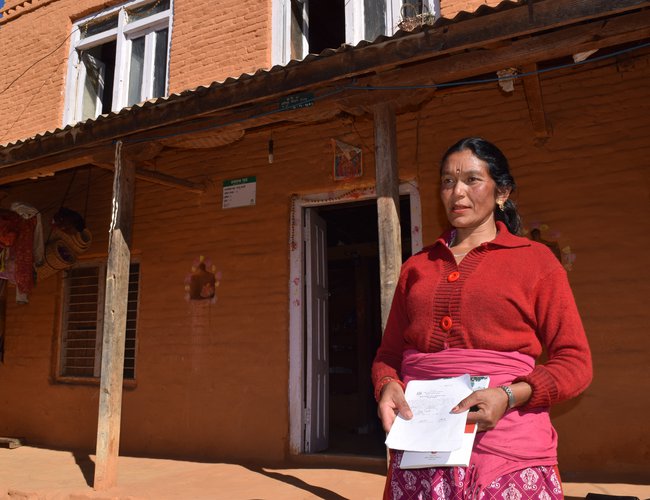
Many victims of the earthquake of April 2015 are still waiting for rehabilitation and relief to become real for them even as two and a half years have passed since the tragedy occurred, killing nearly 9,000 people, and destroying thousands of houses and other structures.
Following the deadly tremors, the government carried out rescue and relief distribution promptly, announcing an initial grant of Rs 300,000 for the affected people to build new houses as well as other housing loan schemes.
Loan Scheme
Eligible families of quake victims could receive a maximum of Rs 300,000 in interest free loan in the lump sum, each loan against the community collateral or collateral of their under-construction house for house construction. A quake-hit family could take out a loan of up to Rs 2.5 million in Kathmandu Valley and Rs 1.5 million outside from different banks and financial institutions at subsidized interest rate of 2 percent, to be repaid in three to five years.
Nepal Rastra Bank (NRB), the central bank of Nepal, announced a concessional loan scheme for the earthquake victims for the reconstruction of their houses destroyed in the earthquake of April 25 and its aftershocks.
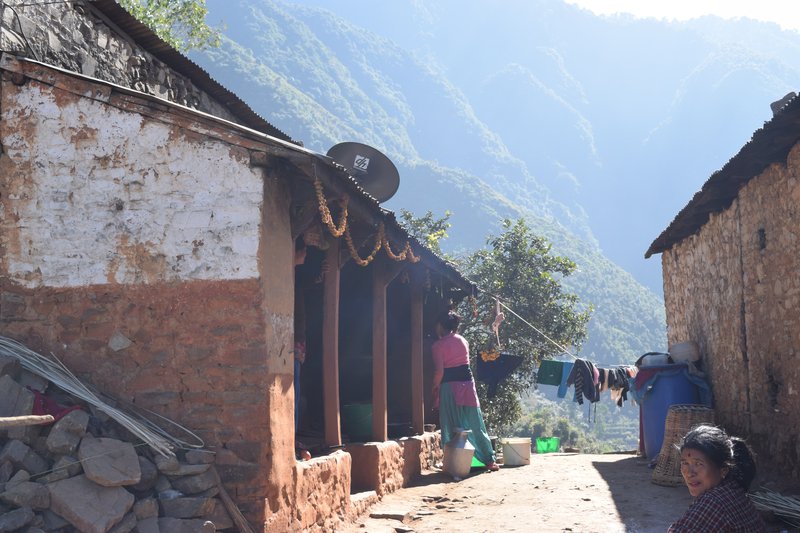
Waiting for a loan
According to the Bank, soft loan will be made available by commercial banks, development banks and finance companies at a meager 2 per cent interest rate.
For this, the NRB will, with the concurrence of the government, make refinancing available to the lending banks and financial institutions (BFIs) at 0 per cent interest for one year, which will be renewed thereafter.
No extra charges
Other than the interest, the BFIs will not be allowed to levy any other charges such as loan processing and pre-liquidation charges or other commissions. The loan will run from five to 10 years in tenure. The total loan amount under the scheme will be a maximum of 80 per cent of the core capital of a bank or financial institution. The NRB will not provide refinancing against the excess of the loan over the prescribed limit. The loan will have to be insured, which will provide a cushion to the lending banks and financial institutions.
However, it is hard to understand why the government discriminated between the victims of the capital valley, who are entitled to get Rs. 2.5 million in loan, and those living outside the valley, who are entitled to Rs 1.5 million in loan. An amount of Rs. 2.5 million is not adequate to build a concrete house. Therefore, the government should reconsider the loan entitlement and provide Rs. 2.5 million to all the genuine earthquake victims entitled to the loan, regardless of whether they are living in the valley or outside.
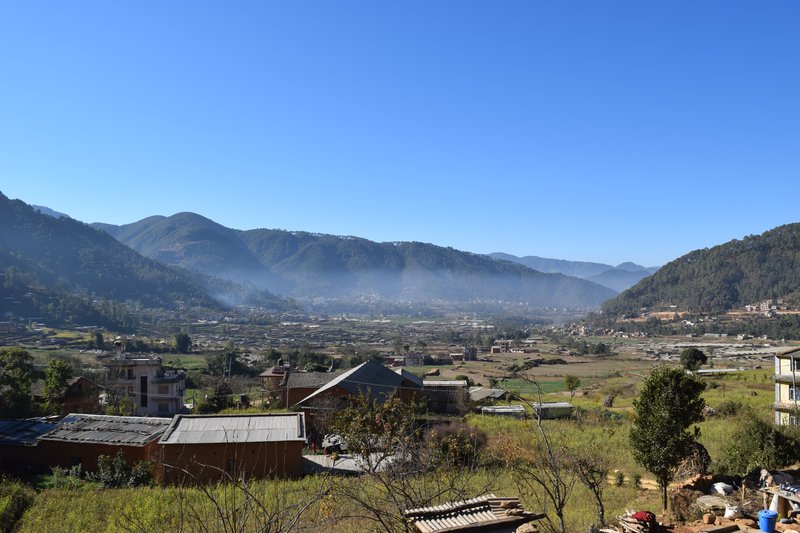
People are still living in Temporary Shelter in Godvari
No Implementation
These plans are, however, yet to be executed fully, either for failure on the part of the concerned authority to act accordingly or due to unawareness of the targeted people.
As for the interest free-grant, the scheme has not come into operation so far, while available data show only a few of quake victims have taken out the subsidized loan so far, thanks to reluctance of various authorized banks and financial institutions (BFIs) to issue the loans. The BFIs said confusion over the criteria and procedures to issue the subsidized loan have made the matter worse.
Failure to implement the scheme in full fledge is likely to hit the aim of the National Reconstruction Authority (NRA), an authorized body for carrying out post-quake reconstruction, to begin the loan process by the Nepali month of Asar of 2075 B.S
The provision of interest-free loans was also mentioned in the speech of the government’s annual budget 2016-17. The provision had got a nod from a Cabinet meeting. The Finance Ministry has also issued a work procedure in coordination with the Rastra Bank and the NRA for the interest-free loan.
The NRA said the program was introduced targeting the lower income farmers, landless families, and labourers. Banks that are categorized into ‘A’, ‘B’, ‘C’ and ‘D’ classes and financial institutions recognized by the Rastra Bank can release the subsidized loans.
The work procedure imposes some terms and conditions for receiving such loans. People whose houses were destroyed in the quake and those holding the identity card as quake victims would be eligible for the grant.
According to the procedure, community collateral, against which the BFIs would disburse such loans, should be secured by the Credit Information Bureau.
The Financial Sector Management Division, under the Finance Ministry, of the government will establish a fund at the Rastra Bank, Banking Office, Thapathali, to pay interest, insurance and security charges on the disbursed loans. The Rastra Bank is required to pay the BFIs' interest, insurance and security fee claims on a quarterly basis.
The interest rate, alongside the BFIs' investment, will be raised by two percent. A committee under the deputy governor of the Nepal Rastra Bank, with respective regional representatives, will be formed to coordinate and monitor the execution of such interest-free loans.
Other members of the committee will include joint secretary of the Finance Ministry, joint secretary of the NRA, and president of Nepal Bankers’ and Association. Executive director for the Banks and Financial Institution Regulation Department at the Rastra Bank will be member-secretary.
Blame Game
The concessional loan of Rs 2.5 million and Rs 1.5 million announced by the government is yet to come into full implementation, thanks to various problems involved.
Under the scheme, Rs 1 billion and 42.2 million have been released through various 22 BFIs so far, according to the NRA. The BFIs are yet to expand their service to the total quake-hit 126 municipalities and rural municipalities for the affected people to receive the loans.
For the part of the Central Bank, its Spokesperson Narayan Poudel said the bank was facilitating the BFIs in distributing the loans to the victims. It has also been refinancing the BFIs by issuing loan again as well, he added.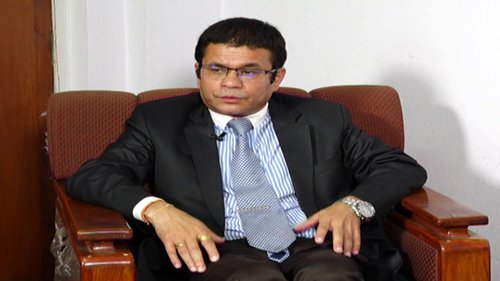
On May 27, 2015, the Central Bank announced refinancing at zero percent interest to the BFIs under the loan scheme, and issued circulars to them to act accordingly. In return, the BFIs would have to issue the loans at two percent interest.
According to National Reconstruction Authority, 604 households received concessional loan between 1.5 million to 2.5 million rupees under 2 percent interest per annum.
In the initials days, the BFIs refused to issue the loans citing confusions over the criteria and procedures. Confusions over quake victim’s identity, documentation procedures, the requirement of for collateral and other factors, among others, are to blame for the delay of nearly six months for the loan scheme to come into full operation.
Acting President of the Nepal Bankers' Association Gynendra Prasad Dhunga said that eligible quake victims would get the loans hassle-free after going through due processes, while claiming that no such victim has been returned empty-handed on such various pretexts as reported.
The only concern of the
BFIs is whether or not the debtors can repay the loans, he said. A long halt in
approving house design, elections, apathy of the victims themselves, and
suspicions that the two percent interest on the loans may increase are some
factors behind the reluctance of the quake victims to take out a grant loan, he
said.
The BFIs believed that the quake victims are attracted to the relief announced by the government shortly after the quake, rather than the loans as announced by the Rastra Bank before the relief government announcement.
The BFIs are worried,
however, about their other loan schemes that are issued at normal market
interest rate (10 percent on average) once the quake victims (approximately
800,000 households) are issued the subsidized loan at only two percent
interest.
Lack of Awareness about Concessional Loan
Unawareness about the subsidized loan has also made the matter worse. Pradip Rayamajhi of Temal rural municipality in the worst quake-hit Kavrelapanchok district, whose house was damaged in the quake, is ignorant about the loans. "I have heard about it but do not know where to go and whom to meet for it," he said.
Another quake survivor Sitaram Koirala of Indrawati in Sindhupalchok district complained that only those having connections with those in power could avail of the facility.
He said despite
approaching the branch of the Rastra Bank, Melamchi, many times for the loan,
he had not received it so far.
"The bank said it would release the loan only after studying an under-construction house. My under-construction house is around three-hour walk from the bank. One month has passed since, but the bank officials are yet to come and survey my house. I am running short of budget to continue the construction," he said.
Khila Prasad Dahal of Melamchi in the district, whose house was damaged completely, and who also lost his four member relatives in the disaster, is yet to begin to build a new house for want of budget.He said housing grant provided by the government is not enough for building a new house.
Another quake survivor Mekh Narayan Shrestha of Ramechhap district accused the authorized financial institutions of trying to escape by showing ignorance about the subsidized loan of Rs 1.5 million.
On the interest-free Rs 300,000 loan, Dhungana said an agreement to this effect was yet to be reached due to lack of clear outline in relation to loan issuance.
He said the BFIs would not agree to the existing work procedure that states that interest on the loans will be provided by adding only up to two percent point on operational cost.
"The work procedure has stated that the loans be issued to the quake victims. The authorised banks' base rate has double digits. They have six or seven percent cost of fund. If this procedure is obeyed, the loan is to be issued below the base rate, which is impossible," he said.
The BFIs' only concern is security of their loan issued to the quake victims, he said. Poudel said the BFIs were hesitant on issuing the loans due to confusions in some points of the procedure.
"Various rounds of discussion took place between the Rastra Bank, the NRA and BFIs in this regard. Efforts were on however to reach consensus by amending the existing work procedure," he said.
The NRA said discussions on the issue were taking place with concerned stakeholders after forming a committee under the leadership of the chief of the NRA's development assistance coordination and facilitation committee.
Complicated Criteria
Although NRB argues that it wants to distribute the soft loan to the victims, the guideline formulated by the bank is very complicated and tedious. One needs to present several criteria to the bank or financial institution where they are applying for the loan.
According to the guidelines, the BFIs decide whom to disburse the loan and who earns “satisfactory” income to service the loan. They are also concerned about who can produce adequate collateral. Given the provision, not all the earthquake victims whose houses were made uninhabitable in the earthquake will be able to avail of the loan.
As far as collateral is concerned, an earthquake victim who has secured a loan defaults, the collateral will have to be auctioned off to recover the loan amount along with the interest accrued thereon.This is because the BFIs will follow the credit policy guidelines while disbursing the loan. There will be no distinction between such borrowers (earthquake victims) and other general borrowers.
Also, the loan scheme is silent on levying penal interest on an overdue loan as it simply states that the BFIs cannot charge over 2 per cent interest on the loan and that the interest rate cannot be revised up throughout the loan tenure.
With so many complex and lengthy processes, only a few people can secure the loan and large numbers of people are yet to approach the banks, thereby making the concessional loan scheme useless.
Political Interference
Political interference and failure of the NRA to deliver on time are blamed for the delay. The NRA that was brought through an ordinance had to wait for eight long months to form after the quake due to political interference that was at work right from the beginning.
It witnessed a change of its chief executive four times within just two years of its establishment. It got its first chief executive officer Gobinda Raj Pokharel appointed by the then Nepali Congress-led government.
Thereafter Pokharel was dismissed, and Sushil Gyawali was appointed as its new CEO by the then successive CPN-UML-led government.
Power politics did not end here. Then successive CPN (Maoist Centre)-led government sacked Gyawali and appointed Pokharel again. Gyawali was charged with failure to expedite the reconstruction. The NRA was once again hit, however, after Pokharel resigned as its CEO to run in the recently concluded elections to the House of Representatives and State Assemblies.
Now the NRA has Yubaraj Bhusal as its head. Given the changing fate of the NRA, with each new government formed under the leadership of a new party, Bhusal's continuity in office may be in doubt once the next government is formed.
What is interesting is that there is a change of its CEO every time on charges of failure to speed up the reconstruction work, but what has played a big role in the change is the political power.the formation of NRA. The then NC-led government had announced to form the NRA, an authorized body for the post-quake reconstruction. Despite the then coalition partner UML's bargain for the coveted position, Pokharel was appointed as its chief about four months after the quake.
Later the NRA was dissolved following the failure to endorse the Reconstruction Bill on time. Again the UML-led government appointed Gyawali eight months later despite NC's efforts to continue Pokharel's tenure in office. This happened following long failed efforts to endorse the bill due to political parties' bargain for the post.
Under the housing grant, the government provides a grant of Rs 300,000 in three installments each to the family whose house has been damaged in the quake. In the first installment, Rs 50,000 will be released, in the second Rs 150,000 and the remaining 100,000 in the third.
Out of the total
eligible 776,849 quake victim households, only 79,514 have reconstructed their
houses, which is approximately 10 percent, according to the NRA. The total 194,196 new houses are under
construction for the quake victims.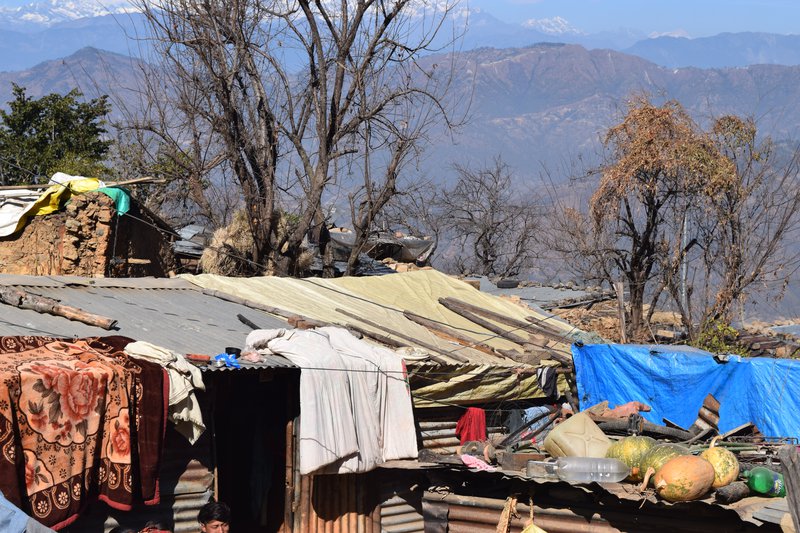
According to data published by the NRA on December 27, a Rs 300,000 housing grant agreement has been struck with the total 676,849 quake victim households so far. Out of them, 664,644 have got the first tranche of the grant, which is around 98 percent, while 115,192 second tranche, which is 17 percent. Likewise, 26,454 received the third tranche, which is only four percent.
Many quake victims are still taking shelter under the open sky, even more than two and a half years since the quake struck on April 25, 2015, killing nearly 9,000 people, and destroying around 800,000 houses.
Earthquake Investigation Banking Loan.pdf
This publication has been supported by The Asia Foundation. The contents of this publication reflect the views of the author(s), researcher(s), and contributing editor(s) and do not necessarily reflect the views of The Asia Foundation.

Kiran Bhattarai
Bhattarai is a Kathmandu based journalist. He has been writing migration issue. He can be reached at kiranbtrai@gmail.com
- Nepali Women Are More Vulnerable In UAE
- Jan 29, 2018
- POST-QUAKE SINDHUPALCHWOK Migration, Trafficking Surge
- Sep 10, 2017

